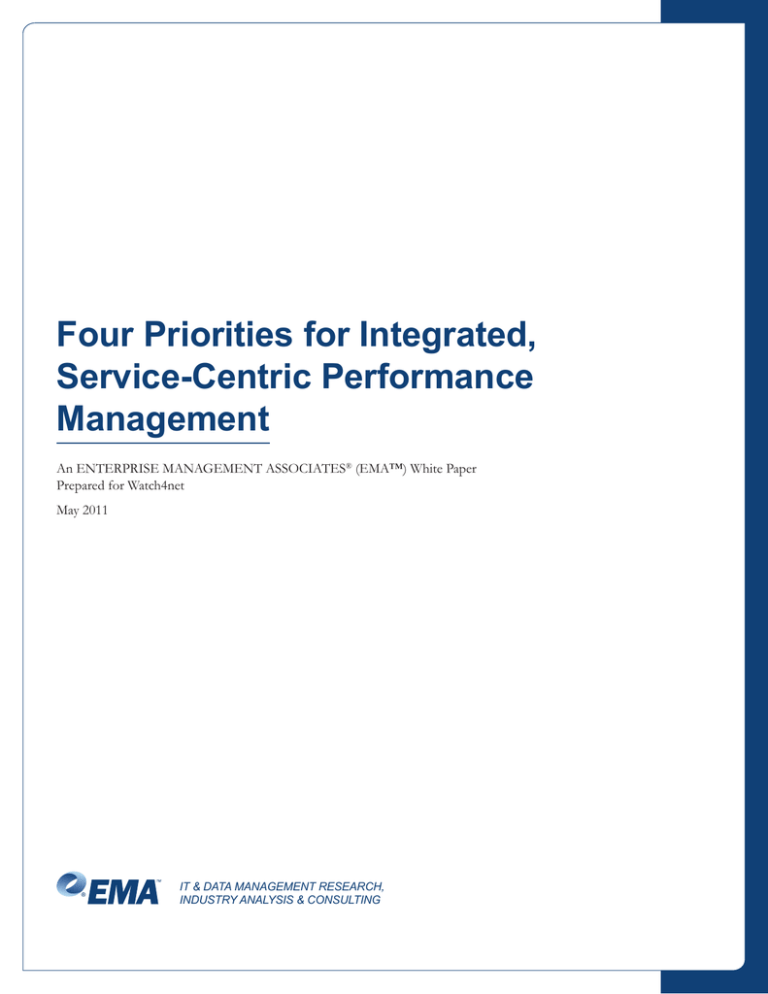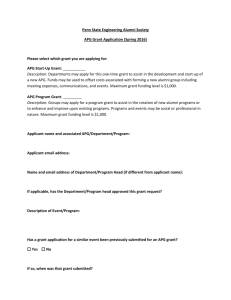
Four Priorities for Integrated,
Service-Centric Performance
Management
An ENTERPRISE MANAGEMENT ASSOCIATES® (EMA™) White Paper
Prepared for Watch4net
May 2011
IT & DATA MANAGEMENT RESEARCH,
INDUSTRY ANALYSIS & CONSULTING
Four Priorities for Integrated,
Service-Centric Performance Management
Table of Contents
Executive Summary..............................................................................................................................................1
Managing Performance in the Age of Virtualization and Cloud.................................................................1
Four Priorities for Performance Management................................................................................................2
Flexibility...........................................................................................................................................................2
Scalability..........................................................................................................................................................2
Service-centricity.............................................................................................................................................2
Cross-domain Technology Support............................................................................................................3
Getting There – Options for Deploying Advanced Performance Management......................................3
Watch4net APG – Integrated, Service-Centric Performance Management..............................................5
EMA Perspective...................................................................................................................................................7
About Watch4net..................................................................................................................................................8
©2011 Enterprise Management Associates, Inc. All Rights Reserved. | www.enterprisemanagement.com
Four Priorities for Integrated,
Service-Centric Performance Management
Executive Summary
A new frontier faces operations teams making the transition from focusing on device availability
to focusing on service quality and performance. Making this change requires expanding the scope
of management activities and rethinking management tools architectures to embrace sustained
performance monitoring spanning all of the contributing technologies and domains that must come
together to comprise today’s highly flexible and dynamic services. Tooling options for integrated,
service-centric performance management include single-vendor suites, domain-specific best of breed
products, and a promising alternative – cross-domain, integrated performance managers. This latter
class can offer a compelling balance of functional capability matched with low integration costs and
low total cost of ownership. This ENTERPRISE MANAGEMENT ASSOCIATES® (EMA™) paper
evaluates priorities for service-centric performance management and analyzes how one cross-domain
integrated solution, Watch4net’s APG, measures up.
Managing Performance in the Age of Virtualization and Cloud
Today’s IT infrastructure managers have always had a tough job, trying to keep up with network, server,
application and client growth as well as keeping up with new technology introductions without growing
staff. But the dual disruptive trends of server virtualization and Cloud services represent challenges
of unprecedented scale. These two related evolutions bring with them new levels of complexity,
growth (in number of managed elements), and high rates of change. They are also catalysts in another
significant organizational and cultural change – the inevitable shift towards service-centric operations,
as a byproduct of turning IT into an internal private Cloud provider to its served organization.
These changes are nothing less than revolutionary to many IT
organizations, spawning re-assessments of management tools,
These changes are nothing
technologies, and practices in order to achieve cross-domain alignment
less than revolutionary
to the new service-oriented mandate. The recent EMA research report,
to
many organizations,
Network Management and the Responsible, Virtualized Cloud (February 2011)
spawning re-assessements
indicates that most organizations adopting server virtualization and Cloud
of tools, technologies,
services are seeing direct impacts across multiple management disciplines
and management tools as a result. Of those sampled, the top two areas
and practices
impacted when deploying Cloud services were Network Performance
Management (59%) and Application Performance Management (56%).
Further, among those actively deploying server virtualization, over half (53%) indicated that they had
purchased and deployed new management tools for monitoring and troubleshooting. EMA analysis
indicates that much of this has been driven by the rise of a new organizational construct, Cloud-specific
and cross-domain support teams, which between 2009 and 2010 grew 50% to clearly become the most
commonly reported as primarily responsible for Cloud service performance and quality management.
From the tools and technology perspective, this means re-examining current management products
to determine if they will keep pace, directly providing or (at least) directly contributing to integrated
viewpoints. Further, they will need to deliver scale, automation, and flexibility to keep up with the
increasingly dynamic nature of the managed environment. Manual, rigorous analysis must be possible
but should be avoided as a primary means of troubleshooting, so that when problems do occur,
diagnosis can be conducted in an efficient, top-down manner. Management systems should provide
proactive indications of issues before they become incidents, ultimately improving both MTBF as well
Page 1
©2011 Enterprise Management Associates, Inc. All Rights Reserved. | www.enterprisemanagement.com
Page 1
Four Priorities for Integrated,
Service-Centric Performance Management
as MTTR. Finally, it is imperative that service orientation be included across the management tools
architecture, so that operations may more closely tie their day-to-day and minute-to-minute actions and
priorities to those applications and services that are most critical to the businesses and organizations
they support.
Four Priorities for Performance Management
These high level objectives can be broken down into many specific requirements for management
tools. Following are more detailed discussions of four key areas of priority, which EMA has identified
for assessing the ability of management tools to facilitate the transition to and ongoing support of
virtualized and Cloud infrastructures:
Flexibility
A primary attraction of both Cloud and virtualized environments is flexibility and agility, offering the
opportunity to rapidly enable changing business priorities and initiatives. With an agile infrastructure
comes the need for agile infrastructure management. Flexibility in performance management means
that solutions must be able to readily accommodate regular, even
frequent changes in composition of and relationships between elements
Performance management
in the infrastructure. Helpful here are capabilities such as a rich existing
priorities can be grouped
library of supported element types, configuration-based customizations
into four areas: flexibility,
that can be executed as needed by operators (rather than requiring
product development or external professional services), and automated
scalability, servicerecognition of changes in the managed environment that are embraced
centricity, and cross-domain
via automated adjustments to monitoring profiles and regimes.
technology support
Scalability
Rarely do today’s IT infrastructures go through a prolonged period of contraction – much more common
is steady, continuous growth. And not all that uncommon is explosive growth, particularly when enabled
by technologies such as server virtualization, which makes deploying new servers almost trivial. Even in
organizations that are relatively static in terms of their overall size, the number of connected elements
that make up the application and service delivery environments seems to grow inevitably.
Performance management tools are particularly stretched by this trend in two important ways: First,
the number of managed elements continues to grow, especially if the solution will be covering multiple
technology domains, so they need to be highly scalable and optimized for collecting hundreds of
metrics from thousands of sources. Secondly, performance management systems collect large volumes
of metrics that must be made available as quickly as possible (for real-time incident troubleshooting
and diagnostics) but also warehoused for long periods of time (for planning and problem analysis),
resulting in substantial storage needs.
Service-centricity
There has long been a growing trend within IT to move away from break-fix, reactive operations that
addressed issues on a “loudest first” basis and towards business-aware, proactive practices that assure
the most mission-critical applications are maintained above all others. This has been standard practice
within the service provider community for years, and within enterprises, initiatives such as ITIL, CoBIT,
and Six Sigma have been adopted by a growing number of forward-looking organizations committed to
Page 2
©2011 Enterprise Management Associates, Inc. All Rights Reserved. | www.enterprisemanagement.com
Page 2
Four Priorities for Integrated,
Service-Centric Performance Management
Performance management
tools must include a means
to recognize relationships
between monitored
elements and the services
they participate in delivering
moving towards a service-centric approach to IT. But for the industry
as a whole, the relatively recent concept of an internal private Cloud is
catching on fast and accelerating this evolutionary process.
Performance management tools need to support this transition in
a few very specific ways. First, there must be a means to recognize
the relationships between each of the monitored elements or
components and the applications and services they are expected to
participate in delivering. This is commonly accomplished via the use
of modeling, and includes attributes such as user/customer, service
type, and Service Level Agreements (SLAs). Next, device-specific viewpoints must be complemented
with service-experience metrics, so that IT can understand not only what it thinks it is delivering but
also their user/customers’ experience in receiving those services. And finally, views into performance
health, status, and activity must be viewable on a service-by-service basis tuned to the structures of the
served organization, not solely on the basis of technology employed.
Cross-domain Technology Support
Related to service-centricity, and perhaps required to achieve truly service-oriented operations, is
the need to bring together performance and health data from each of the technology domains that
make up today’s complex, multi-tiered, widely distributed delivery infrastructures. With the advent of
virtualization within every layer of the stack, the traditional boundaries between technology domains
(servers, networks, storage, and applications) are blurring, and the interdependencies and relationships
between them are becoming increasingly important. Consequently, performance management systems
that can draw and relate performance metrics for multiple technology domains can deliver great
advantages, aggregating and correlating data to shorten the path to actionable operational intelligence.
The challenge here, of course, is that performance tools must be flexible enough to be able to
accommodate the wide variety of specifics within each domain and the sometimes-wide variety of
management interface technologies needed to collect performance data successfully. Further, they
must be able to recognize multiple technologies within each domain (for instance, mobile/wireless
access combined with managed services and high speed core networks in the datacenter) while also
spanning application, compute, storage, and delivery tiers.
Getting There – Options for Deploying Advanced
Performance Management
When evaluating strategies and solutions to meet these and other organization-specific requirements
for performance management, the number of choices can be daunting. One of the most important
questions to be asked is how much your organization prefers to work with a single vendor versus
multiple vendors of management technology. There are three primary approaches in this regard:
1. Use best-of-breed performance tools for each domain and link them together with an
operations bridge. The advantages of this approach are that there are often unique, domaincentric features that can only be found via best-of-breed systems, and such systems will often
be the first to deliver integrated support of new leading-edge/bleeding-edge technologies. The
disadvantages of this approach are that operators are often left with primary responsibility for
Page 3
©2011 Enterprise Management Associates, Inc. All Rights Reserved. | www.enterprisemanagement.com
Page 3
Four Priorities for Integrated,
Service-Centric Performance Management
integrating systems, and as a result the overall tools architecture can
suffer from fragility due to the challenge of coordinating multiple
product releases and patches. Another disadvantage is that best-ofbreed tools often have their own distinct paradigms for consoles/
dashboards/reports as well as system administration, resulting in
increased learning curves and less facile support for collaboration.
Finally, this approach tends to be the most expensive overall, due
to the combined need for commissioning and maintaining custom
integrations and the fact that tools must be licensed independently,
leaving little opportunity for leveraged negotiations.
Options for advanced
performance management
tools include per-technology
best of breed, broad
suites, and cross-domain
integrated solutions
2. Add performance management as an incremental element of a broad framework/suite
from a single vendor. This approach offers the advantage of pre-integration as well as (in some
cases) a common administrative and user interface paradigm, reducing deployment and training
costs. The disadvantages of this approach is that suite-based tools are commonly less featurerich, more services-intensive to customize, and slow to adopt and support new technologies due
to the need to verify changes across a solution suite that may be much broader than actually in
use. Further, there is always the danger of “vendor lock-in” with this approach.
3. Use integrated performance management tools that cover multiple technology domains
and integrate them with other systems at the functional discipline level. This hybrid
method has advantages in that some of the chaos is avoided over a technology-specific, bestof-breed approach while still capturing the value of solutions that focus on a specific type of
management functionality, such as performance management. The total number of integrations
can also be reduced, which in turn lessens architectural fragility. The only disadvantages of this
approach are that it does still require an IT team to deal with more management vendor relationships than the framework/suite approach, and there may be somewhat less specialized feature
support than pure technology-specific best-of-breed tools.
Each IT organization will choose from these approaches based on a combination of factors that will
ultimately translate into an assessment of total cost of ownership/operations balanced against the
driving impact costs of downtime or measurable degradations in service performance. Factors that
contribute to this analysis will include cost of maintaining existing products in place and the depth
of staff knowledge versus the time and cost of deploying new, augmentative, or alternative solutions.
In most organizations, the need to maximize functional capability while also minimizing total cost of
acquisition and long-term ownership will naturally lead them towards the cross-domain performance
management approach.
Page 4
©2011 Enterprise Management Associates, Inc. All Rights Reserved. | www.enterprisemanagement.com
Page 4
Four Priorities for Integrated,
Service-Centric Performance Management
Watch4net APG – Integrated, Service-Centric Performance
Management
Headquartered in Montreal and with customers worldwide, Watch4Net has been meeting performance
management needs via their APG performance management system since 2004. Most APG deployments
to date have been within the service provider community, though they have also successfully engaged
enterprise adopters on a regular basis throughout their history.
Watch4Net’s APG solution is built by means of a traditional multi-tiered architecture (see Figure 1.)
Performance data collection is accomplished by means of one or more APG Collectors from IT
infrastructure devices, systems, and components, or from other management systems or data sources.
At the central data consolidation layer is the APG Backend/Database, where all performance data
is compiled, normalized, and stored. At the presentation layer, APG offers Web portals, a deep and
extensive library of pre-existing reports, outbound event/alert APIs, and even an iPhone App. The
solution can be configured to utilize multiple APG elements at each layer for scale and resiliency.
Figure 1: APG Solution Architecture
The APG solution has evolved in a way that naturally supports all four priorities for integrated, servicecentric performance management. Following is a discussion of how each is addressed:
1. Flexibility – In service provider environments, management tools integration is paramount and
there often exists a wide range of management interface technologies. The APG solution was
designed to accommodate these needs, but with one additional specific objective – that existing
interfaces could be modified and new ones added with a minimum of time and effort. Further,
Page 5
©2011 Enterprise Management Associates, Inc. All Rights Reserved. | www.enterprisemanagement.com
Page 5
Four Priorities for Integrated,
Service-Centric Performance Management
the system was designed to provide customers/operators with complete control over the definition and modification of reporting, whether starting from an existing Report Pack template or
creating new reports from scratch. The net result of these design criteria, successfully met within
APG, is a highly flexible solution that minimizes integration effort, customization effort and
architectural fragility.
2. Scalability – Also a side benefit of being designed for large-scale service provider settings,
the APG solution can readily accommodate hundreds of thousands of managed elements and
millions of performance metrics. The APG architecture supports distributed, balanced loading
at all tiers – collection, database, and presentation – as well as High Availability configurations
to assure operational continuity if any management components themselves happen to fail.
Collectively, this puts APG in league with the best in the market for scale and reliability.
3. Service Centricity – All performance data brought into the APG system is aligned and correlated with service constructs and service level agreement definitions. Services can be defined
directly within APG and reconciled/updated via integration with an external CMDB/CMS or
service management database. This allows operations teams to monitor performance and triage
responses to existing or potential performance issues based on impact and business priority
(see Figure 2). The system includes common core reports for SLA reporting, and fully supports
multi-tenancy, another customer/service-centric set of features for managing data and portal
access/presentations on a customer-by-customer, service-by-service, line-of-business by lineof-business basis.
Figure 2. Service and SLA status dashboard view
Page 6
©2011 Enterprise Management Associates, Inc. All Rights Reserved. | www.enterprisemanagement.com
Page 6
Four Priorities for Integrated,
Service-Centric Performance Management
4. Cross-Domain Technology Support – Perhaps the most unique capability within APG is
its ability to support data collection, correlation, and presentation across all of the technology
domains that must come together seamlessly to deliver today’s complex, composite applications
and services. A great example of this is the solution’s support for VCE Vblock deployments,
where storage, networking, physical computing and virtual computing are all brought together in
a single integrated system (see Figure 3). Beyond physical/virtual infrastructure, APG supports
direct collection of performance data from within the application layer, covering the last of the
major components that will come together to complete internal private Cloud services.
Figure 3. Vblock integrated web portal view
With strong support for all four priorities, the APG solution is fully capable of playing the role of
common performance management platform across all components that make up today’s complex,
composite Cloud architectures.
EMA Perspective
The clearest path to IT’s future opportunity, to evolve from tactical cost center to strategic business
enabler, is service-oriented management. The Internal Private Cloud phenomenon, where existing IT
infrastructure and applications are restructured and re-launched as internal services, may hold the key
for many organizations to finally embrace service-centricity. EMA strongly advocates for the adoption
service-oriented approaches across all management disciplines and for requiring that core management
tools and technologies support integration and automation of service-oriented management practices.
For any IT organization in the process of considering or planning a transition to an internal private
Cloud operating model, evaluation of management tools, technology, and architecture is an essential
and strategic step in that process.
With the breadth and depth of their APG performance management system, Watch4Net has delivered
a solution that can viably support hybrid management tools architectures by crossing multiple domains
and consolidating performance management data across network, systems, storage, and applications.
The system’s flexibility bodes well for accommodating new technologies, and its scale is among the best.
Page 7
©2011 Enterprise Management Associates, Inc. All Rights Reserved. | www.enterprisemanagement.com
Page 7
Four Priorities for Integrated,
Service-Centric Performance Management
And having been built and proven directly within service provider environments, it has an intrinsically
service-oriented architecture that offers a clear advantage for anyone heading in that direction. With
these strengths and attributes in place, Watch4Net’s APG solution should be a considered a valuable
and viable candidate for managing performance in emerging Cloud infrastructures.
About Watch4net
Watch4net is a leading provider of carrier-class service assurance software. Enterprises and
service providers around the world use Wach4net’s flagship APG Software Suite for performance
management of the network, data-centers and cloud infrastructures. APG consolidates, unifies
and analyses information to provide real-time, historical, and projected visibility into the health
of infrastructures and business services. Privately held and headquartered in Montreal, Watch4net
has an offices in Canada, Germany and UK to serve its fast growing customer base. For more
information, visit www.watch4net.com.
About Enterprise Management Associates, Inc.
Founded in 1996, Enterprise Management Associates (EMA) is a leading industry analyst firm that provides deep insight across the full
spectrum of IT and data management technologies. EMA analysts leverage a unique combination of practical experience, insight into industry
best practices, and in-depth knowledge of current and planned vendor solutions to help its clients achieve their goals. Learn more about EMA
research, analysis, and consulting services for enterprise IT professionals, lines of business users, and IT vendors at www.enterprisemanagement.
com or follow EMA on Twitter.
This report in whole or in part may not be duplicated, reproduced, stored in a retrieval system or retransmitted without prior written permission
of Enterprise Management Associates, Inc. All opinions and estimates herein constitute our judgement as of this date and are subject to change
without notice. Product names mentioned herein may be trademarks and/or registered trademarks of their respective companies. “EMA” and
“Enterprise Management Associates” are trademarks of Enterprise Management Associates, Inc. in the United States and other countries.
©2011 Enterprise Management Associates, Inc. All Rights Reserved. EMA™, ENTERPRISE MANAGEMENT ASSOCIATES®, and the
mobius symbol are registered trademarks or common-law trademarks of Enterprise Management Associates, Inc.
Corporate Headquarters:
5777 Central Avenue, Suite 105
Boulder, CO 80301
Phone: +1 303.543.9500
Fax: +1 303.543.7687
www.enterprisemanagement.com
2272.052311
Page 8
©2011 Enterprise Management Associates, Inc. All Rights Reserved. | www.enterprisemanagement.com
Page 8





